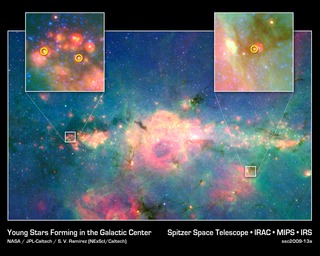
Credit: NASA/JPL-Caltech/D. An (IPAC/Caltech)
Chart • June 10th, 2009 • ssc2009-13b
ssc2009-13b
These data from NASA's Spitzer Space Telescope reveal a newborn star at the center of our Milky Way. Our galaxy's core is a frenzied place, and identifying baby stars there has been difficult. Dust standing between us and the core blocks visible light, but infrared light, as detected by Spitzer, can get through.
To definitively identify newborn stars, astronomers used Spitzer's spectrograph to break starlight up into its basic infrared components. The resulting data, called as spectrum, are shown here for a single star, with signatures of key molecules labeled. Acetylene, hydrogen cyanide and carbon dioxide are all gases known to be associated with newborn stars in other parts of our galaxy. They are produced when young stars heat up gas in their outer envelope. The broad dry ice feature is also characteristic of newborn stars. Spitzer found results for two other stars whose data are not shown here.
About the Object
- Name
- Type
- Star > Evolutionary Stage > Protostar
- Star > Circumstellar Material > Disk > Protoplanetary
- Distance
- 25,000 Light Years
Color Mapping
| Band | Wavelength | Telescope |
| Infrared | 13.0 µm | Spitzer IRS |
| Infrared | 16.0 µm | Spitzer IRS |






